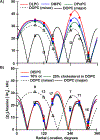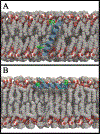Influence of Lipid Saturation, Hydrophobic Length and Cholesterol on Double-Arginine-Containing Helical Peptides in Bilayer Membranes
- PMID: 31150136
- PMCID: PMC6829048
- DOI: 10.1002/cbic.201900282
Influence of Lipid Saturation, Hydrophobic Length and Cholesterol on Double-Arginine-Containing Helical Peptides in Bilayer Membranes
Abstract
Membrane proteins are essential for many cell processes yet are more difficult to investigate than soluble proteins. Charged residues often contribute significantly to membrane protein function. Model peptides such as GWALP23 (acetyl-GGALW5 LAL8 LALALAL16 ALW19 LAGA-amide) can be used to characterize the influence of specific residues on transmembrane protein domains. We have substituted R8 and R16 in GWALP23 in place of L8 and L16, equidistant from the peptide center, and incorporated specific 2 H-labeled alanine residues within the central sequence for detection by solid-state 2 H NMR spectroscopy. The resulting pattern of [2 H]Ala quadrupolar splitting (Δνq ) magnitudes indicates the core helix for R8,16 GWALP23 is significantly tilted to give a similar transmembrane orientation in thinner bilayers with either saturated C12:0 or C14:0 acyl chains (1,2-dilauroyl-sn-glycero-3-phosphocholine (DLPC) or 1,2-dimyristoyl-sn-glycero-3-phosphocholine (DMPC)) or unsaturated C16:1 Δ9 cis acyl chains. In bilayers of 1,2-dioleoyl-sn-glycero-3-phosphocholine (DOPC; C18:1 Δ9 cis) multiple orientations are indicated, whereas in longer, unsaturated 1,2-dieicosenoyl-sn-glycero-3-phosphocholine (DEiPC; C20:1 Δ11 cis) bilayers, the R8,16 GWALP23 helix adopts primarily a surface orientation. The inclusion of 10-20 mol % cholesterol in DOPC bilayers drives more of the R8,16 GWALP23 helix population to the membrane surface, thereby allowing both charged arginines access to the interfacial lipid head groups. The results suggest that hydrophobic thickness and cholesterol content are more important than lipid saturation for the arginine peptide dynamics and helix orientation in lipid membranes.
Keywords: GWALP23; arginine; cholesterol; protein-lipid interactions; solid-state NMR spectroscopy.
© 2019 Wiley-VCH Verlag GmbH & Co. KGaA, Weinheim.
Conflict of interest statement
The authors declare no conflict of interest.
Figures





Similar articles
-
Influence of High pH and Cholesterol on Single Arginine-Containing Transmembrane Peptide Helices.Biochemistry. 2016 Nov 15;55(45):6337-6343. doi: 10.1021/acs.biochem.6b00896. Epub 2016 Nov 4. Biochemistry. 2016. PMID: 27782382 Free PMC article.
-
Proline kink angle distributions for GWALP23 in lipid bilayers of different thicknesses.Biochemistry. 2012 May 1;51(17):3554-64. doi: 10.1021/bi300281k. Epub 2012 Apr 18. Biochemistry. 2012. PMID: 22489564 Free PMC article.
-
Ionization Properties of Histidine Residues in the Lipid Bilayer Membrane Environment.J Biol Chem. 2016 Sep 2;291(36):19146-56. doi: 10.1074/jbc.M116.738583. Epub 2016 Jul 20. J Biol Chem. 2016. PMID: 27440045 Free PMC article.
-
Lipid bilayers: an essential environment for the understanding of membrane proteins.Magn Reson Chem. 2007 Dec;45 Suppl 1:S2-11. doi: 10.1002/mrc.2077. Epub 2007 Dec 19. Magn Reson Chem. 2007. PMID: 18095258 Review.
-
Comparison between the behavior of different hydrophobic peptides allowing membrane anchoring of proteins.Adv Colloid Interface Sci. 2014 May;207:223-39. doi: 10.1016/j.cis.2014.01.015. Epub 2014 Jan 28. Adv Colloid Interface Sci. 2014. PMID: 24560216 Free PMC article. Review.
Cited by
-
Illuminating Disorder Induced by Glu in a Stable Arg-Anchored Transmembrane Helix.ACS Omega. 2021 Jul 26;6(31):20611-20618. doi: 10.1021/acsomega.1c02800. eCollection 2021 Aug 10. ACS Omega. 2021. PMID: 34396006 Free PMC article.
-
Lipid-Dependent Titration of Glutamic Acid at a Bilayer Membrane Interface.ACS Omega. 2021 Mar 17;6(12):8488-8494. doi: 10.1021/acsomega.1c00276. eCollection 2021 Mar 30. ACS Omega. 2021. PMID: 33817510 Free PMC article.
-
A Rigorous Framework for Calculating Protein-Protein Binding Affinities in Membranes.J Chem Theory Comput. 2023 Dec 26;19(24):9077-9092. doi: 10.1021/acs.jctc.3c00941. Epub 2023 Dec 13. J Chem Theory Comput. 2023. PMID: 38091976 Free PMC article.
References
Publication types
MeSH terms
Substances
Grants and funding
LinkOut - more resources
Full Text Sources
Medical

